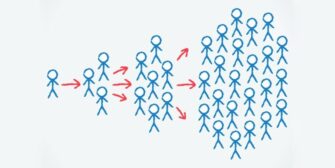Want Your Ad to Go Viral?
Go catch lightning a bottle. Maybe not. Maybe it isn’t random. But what it certainly isn’t is “brilliant” or “emotional” ads. The characteristics of the ad do matter but there is a lot of interplay with characteristics of the viewers.
In short, part ad, part people. And, one can argue, as we will, that the ad characteristics should be determined, at least in part, by the people characteristics, which would mean the people part is more important than the ad part.

And, in keeping with the DonorVoice view of the world, not all people are the same because we don’t all have the same base traits and characteristics (e.g. Identity, Personality). Therefore, different ads for different folks.
There was a recent study exploring the root cause of viral ad sharing. Participants in this research were randomly assigned into different treatment groups and shown different types of ads,
- Emotional (ad for Google)
- Informational (ad for a Volvo)
Prior to ad exposure they answered a set of survey questions that measured their Personality. After seeing the ads the participants answered more survey questions to measure…
- Attitudes toward the (target) brand
- Attitudes toward ad
- Perceptions of message complexity
- Product involvement
- Gender
Guess for yourself which set of factors influenced ad sharing the most? The ad, the brand, or their Personality traits? I’ll stop typing, go ahead and guess…still stopped.
Their attitudes toward the brand and their Personality – i.e. who they are as people. That’s it. Attitudes toward the ad, emotional arousal, message complexity, product involvement, and gender had no bearing on ad sharing.
The Personality part of all this is what’s most interesting, useful, and in line with anything coming close to real (not fake) donor-centricity, which we’ll underscore again, cannot be done if you’re base assumption is that everyone is the same.
Almost everyone says, “We don’t think everyone is the same.” Yet, if you are doing a direct marketing test where you’ve got a test idea that simply goes to a random sample of donors, then the your base premise for getting human beings to give you money is that they all do it for the same reason, whether stated or not.
The researchers in this ad testing experiment found that people who have a high need for cognition (more on this in a minute) are…
- much more likely than those with low need for cognition to share an ad and,
- that those high in cognition are much more likely to share an informational ad over an emotional one.
The Big Five perspective identifies need for cognition as a blend of high Intellect (from the Openness domain) and orderliness (from the Conscientious domain). People with a stronger “need for cognition” want to make sense of new information (Intellect) and go through the effort of mentally organizing it (Orderliness). The problem, aside from keeping the measures “clean” and distinct is in making use of this for targeting purposes.
One is better off making ads aimed at High Need for Cognition people if sharing them is a goal since these are the folks more likely to do so. Further, the ad should contain brand elements and extra details that might not normally make the cut.
This isn’t to say it’s dry and fact laden. Narrative form still trumps for a variety of reasons but this is about making the story longer and more involved to best register with the folks most likely to share it.
The rub is that because “High Need for Cognition” is a bit of a bastardized measure it makes it tougher to take advantage of the demographic differences that exist in the Big Five.. To wit, because it’s part Openness and part Conscientiousness it means you should target liberals (Openness) and conservatives (Conscientious), which is akin to saying you target those under and over 50.
Where does this leave us? Here’re the key takeaways.
- As always, it is much more about the one being asked than the one doing the asking (regardless of what type of ask).
- People are very different in very predictable ways on their “why” for giving time or money.
- If your communication is one size fits all (the vast majority are) then your base, operating assumption is that everyone is the same.
- We need to get much better at segmenting based on who folks are in ways that get at root cause. Hint: nothing about age, channel, or demographic is predictive even if it is descriptive.
- We spend way too much time on the creative absent anything close to sufficient knowledge or understanding of the recipient.
- As for viral ads, aim for high-Openness folks, which means aim for people who are more liberal, and more into the arts, culture, and other intellectual pursuits.
- Also, make the ad more involved and informative (using narrative). One example, don’t simply state that the kid was hungry and got fed. Show (don’t tell) how that helped him concentrate in school, do better, and stress out his parents less, making them better able to focus while at work.
Kevin


